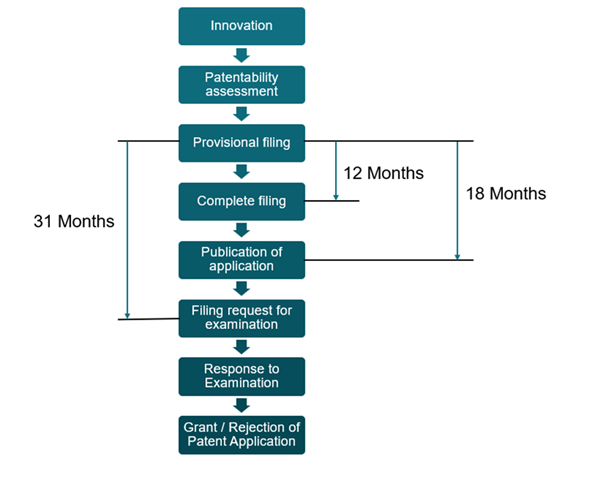


India’s economic rise on the world stage is being fueled by a wave of innovative startups and Micro, Small, and Medium Enterprises (MSMEs). These entities are not just business engines—they are vital sources of employment, disruption, and technological leapfrogging, especially in India’s rapidly evolving startup landscape yet, even as the world recognizes India’s prowess as a cradle of new ideas, a crucial factor sets apart those who succeed from those who fade into obscurity: the proactive use of intellectual property (IP) rights.
Among the various forms of IP, patents stand out as a key tool to empower startups and MSMEs, providing legal protection, enabling commercialization, improving valuation, and fostering an ecosystem of ongoing innovation. However, while many Indian entrepreneurs are adept at innovation, the journey through patenting remains shrouded in myths and perceived difficulties.
This exhaustive article is a step-by-step roadmap crafted explicitly for Indian startups and MSMEs seeking to harness the full power of patents—detailing every aspect from ideation and search to filing, leveraging government incentives, and long-term management, while providing illustrative examples, best practices, and actionable calls to action.
The Strategic Value of Patents for Startups and MSMEs
Why Bother with Patents?
A patent is essentially a monopoly right granted by the government to an inventor or applicant for 20 years from the filing date, preventing others from making, using, selling, or importing the patented invention without permission. The value for startups and MSMEs is multi-dimensional, including:
Case Study Highlight
alphaTUB®, a notable Indian startup, built strong IP protection through a patent portfolio that enabled it to thrive globally, stand firm against international competitors, and expand into lucrative foreign markets—an inspiring demonstration of how IP fuels resilience and global ambition.
Intangible Assets Drive Today’s Value
The economic landscape has shifted: by 2005, 84% of the S&P 500’s asset base was intangible, compared to just 17% in 1975. For most innovative businesses today, patents, copyrights, and other IP outstrip the value of physical assets. For startups and MSMEs in India, this is not theory, but an urgent reality.
The Roadmap: Step-by-Step Patent Journey for Startups & MSMEs
Before you even begin the formal patent journey, meticulously document your invention. This includes:
Dated and signed lab notebooks, with records of development, help establish inventorship and the timeline, which can be crucial in the event of disputes.
All documentation should be kept strictly confidential until a patent application is filed. Public disclosure (conference, publication, website, investor pitch) can destroy patentability in India and most countries.
To be granted a patent, your invention must:
Check for published patents, non-patent literature, journal articles, and industry reports using databases:
Professional patent agents or search firms can conduct a thorough landscape search with specialized tools and domain knowledge, which is strongly recommended to avoid surprises later.
Startups often begin with a provisional application when the invention is at an idea or prototype stage:
Within 12 months, a complete application (detailed and with claims) must be filed. This formalizes the scope of your invention and what you are seeking to protect.
Tip: Filing a provisional is highly recommended for startups and MSMEs developing rapidly—protection from day one, with no risk of losing rights during development.
The heart of the patent is its claims section. Artful claim drafting ensures broad, powerful protection. Overly narrow claims can be easily circumvented; overly broad claims risk rejection or invalidation.
Advice: Use a Registered Patent Agent—they add value in both legal compliance and maximizing the enforceability and breadth of your patent.
Online Filing: Most entrepreneurs favor IP India’s online platform (ipindiaonline.gov.in) for convenience, tracking, and e-payments.
Physical or Offline Filing: Regional Patent Offices are in Kolkata (HQ), Delhi, Mumbai, and Chennai—but online is now most common.
Form 1: Application for grant
Form 2: Provisional or Complete specification
Form 3: Statement and undertaking
Form 5: Declaration of inventorship
Form 26: Power of attorney (if using an agent)
Fees: Significantly lower for startups/MSMEs (attach DPIIT Startup or Udyam/MSME certificate)
Startups, MSMEs, women applicants, and some special cases can request fast-track examination and patenting at minimal/additional cost, drastically shaving grant timelines from multiple years to as little as 12 months.
Patent applications are typically published 18 months after the earliest filing/priority date.
If requested by the applicant (by paying a fee), publication can occur within a month of the request—accelerating examination and grant.
Importance of Publication: Once published, your application becomes “prior art,” preventing rivals from patenting substantially similar inventions.
The applicant must file Form 18 (Request for Examination) within 31 months of filing. No RFE = No examination!
Startups, MSMEs, women, and government applicants can use Form 18A to request fast-track examination.
After publication and RFE, an examiner reviews the application and issues an FER—a detailed examination report with objections, questions, or requests for amendments/clarifications.
The applicant has 6 months (extendable by 3 months) to respond.
Professional help is invaluable—defend novelty and inventive steps with technical and legal arguments, amend claims if needed, and provide clarifications.
If all examination issues and oppositions are resolved, the patent is granted, published in the official journal, and a certificate is issued to the applicant.
The patent remains valid for 20 years from the earliest priority date if renewal fees (annual from the 3rd year onwards) are paid without lapse.
Tip: Missing a renewal can result in the irrevocable loss of patent rights. Many startups set reminders or use patent attorneys to manage deadlines.
Leveraging Government Schemes and Support for Patents
Central Government Schemes
Launched under the Startup India program, SIPP connects recognized startups with government-paid IP facilitators.
Key Benefits:
Who can apply? All MSMEs registered on Udyam.
Benefits:
State Government IP Incentives
Tip: Always check both central and state-level incentives—most are complementary and can be clubbed for a higher benefit.
IP Facilitation Centers (IPFCs) and Incubators
Role of IPFCs: Situated nationwide, these government-funded centers help entrepreneurs navigate everything from filing to prosecution, commercialization, and enforcement.
Incubators and Accelerators: University-based and private incubators (IITs, state innovation labs, accelerators) provide IP resources, patent clinics, and referrals to trusted legal experts.
Large banks and government-backed lenders: Now accept patents as collateral for business loans—a major win for IP-rich, asset-light startups.
Best Practices and Advanced Patent Strategies
Tips for Maximizing Patent Value
Common Mistakes and Cautions
Case Studies: Indian Success Stories
Utilized a strong IP strategy to maintain exclusivity in both domestic and international markets. Faced with competition from multinational giants, their patents provided not just a shield but a sword to license, defend, and expand.
Filed both Indian and PCT applications using the SIPP and MeitY schemes. Leveraged IP to secure Series A funding, attract scientific talent, and begin exports to Europe and the US.
Secured patent funding from both Maharashtra State and the central MSME scheme, covering almost all filing expenses, and using their patent grant certificate in loan negotiations with a major PSU bank.
Prioritized software patenting in the US/EU (where eligible), but also filed for Indian patents on hardware and method innovations—advising a hybrid IP approach spanning cross-border protection, trade secrets, and copyright.
Graphical Representation: The Indian Patent Filing Flow
(Insert a professionally designed flowchart based on the below steps, or collaborate with your in-house designer to visualize the workflow)

Frequently Asked Questions
Q1: What types of inventions are patentable in India?
A: Any novel, inventive, and industrially applicable process, product, or combination—excluding abstract ideas, mathematical methods, and certain other categories.
Q2: Can software be patented?
A: Pure software and algorithms “as such” are not patentable, but software with a technical effect or embedded in hardware can sometimes be patented.
Q3: How long does it take to obtain a patent in India?
A: Standard route: 2-5 years. Expedited process for startups/MSMEs: 12-18 months, sometimes less.
Q4: What are the costs for startups/MSMEs?
A: Dramatically reduced—filing, examination, and renewal fees are often 10–20% of those for corporates. Government schemes can reimburse further.
Actionable Steps: Your Patent Success Checklist
Conclusion
Securing a patent is not just a legal formality—it is a business imperative in the 21st century. For Indian startups and MSMEs, patents unlock new markets, unleash innovation, and provide protection against the relentless tide of imitation. With government support, reduced bureaucracy, and a rapidly modernizing IP framework, the best time to build your patent portfolio is now.
Are you ready to protect your innovation, capture value, and take your business to new heights?
Contact IP POST for expert guidance across every stage of the patent journey—leverage the smartest strategies, access all eligible schemes, and transform your intellectual capital into enduring success.
Protect your idea. Monetize your insight. Accelerate your growth.
Your IP is your competitive arsenal—use it wisely, use it boldly.

1, MUTHUSAMY STREET,
KAVUNDAMPALAYAM,
COIMBATORE
TAMIL NADU, INDIA
IP POST LLC
312 W. 2ND ST #4173
CASPER, WY 82601
UNITED STATES


